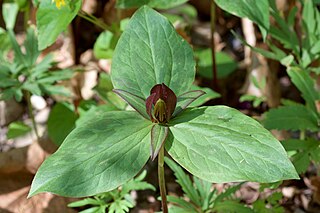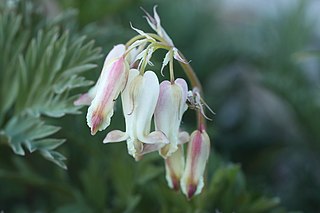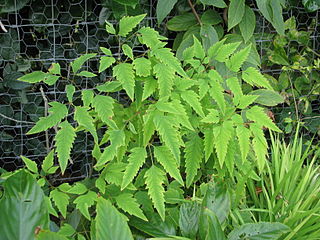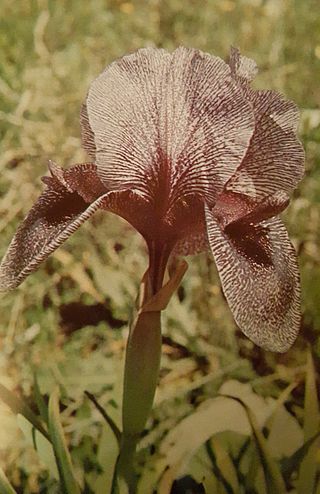
Dicentra, known as bleeding-hearts, is a genus of eight species of herbaceous plants with oddly shaped flowers and finely divided leaves, native to eastern Asia and North America.

Dicentra formosa is a flowering plant with fern-like leaves and an inflorescence of drooping pink, purple, yellow or cream flowers native to the Pacific Coast of North America.

Trillium sessile is a species of flowering plant in the bunchflower family Melanthiaceae. The specific epithet sessile means "attached without a distinct stalk", an apparent reference to its stalkless flower. It is commonly known as toadshade or toad trillium. It is also called sessile trillium or sessile-flowered wake-robin, however it is not the only member of the genus with a sessile flower.

Primula pauciflora, the pretty shooting star, few-flowered shooting star, dark throat shooting star or prairie shooting star, is a species of flowering plant in the primula family Primulaceae. It is a widespread and very variable species, native to western North America, from Subarctic America to Mexico, often in xeric and desert habitats. It is found in the Great Basin Deserts and Mojave Desert. Its synonyms include Dodecatheon pauciflorum and Dodecatheon pulchellum.

Tonella tenella is one of two herbaceous plant species in genus Tonella, which has been recently reclassified as a member of the family Plantaginaceae. This species is known by the common names lesser baby innocence and small-flowered tonella. The plant is a small annual herb with an erect stem up to 30 centimeters tall. The flowers are very tiny, only a few millimeters wide. The corolla is arranged with four petal lobes on one side and one larger petal lobe on the other. The lobed petals are white with blue or purple spots or streaks, and they surround four white stamens. Growing in the forest understory, often scrub oak, on moist rocky soil, its range extends from southern Vancouver Island, British Columbia to San Benito County, California.

Clematis pauciflora is a species of clematis known by the common name ropevine. This flowering plant is native to the high desert and chaparral slopes of southern California and Baja California. It is a woody vine with nodes every few centimeters which produce leaves and flowers. The leaves are made up of several dark green lobed leaflets, each one to three centimeters wide. From each leaf-bearing node grows an inflorescence of one to three flowers with narrow petallike sepals in shades of light yellow. Most of the flower is made up of a spray of up to 50 stamens and almost as many similar-looking pistils. The fruit is an achene equipped with a long plume-like style. The specific epithet pauciflora is Latin for 'few-flowered'.

Dicentra nevadensis, the Sierra bleeding heart or Tulare County bleeding heart, is a perennial plant endemic to gravelly outcroppings in the Sierra Nevada peaks of Tulare and Fresno Counties in California.

Dicentra eximia is a flowering plant with fernlike leaves and oddly shaped flowers native to the Appalachian Mountains. It is similar to the Pacific bleeding-heart, which grows on the Pacific Coast. Dicentra eximia is a perennial herb in the Papaveraceae family.

Frankenia pauciflora, the common sea-heath or southern sea-heath, is an evergreen shrub native to southern Australia. It is part of the Frankenia genus of the Frankeniaceae family.

Brunfelsia pauciflora is a species of flowering plant in the family Solanaceae, the nightshades. It is endemic to Brazil, and it is grown in cultivation. A shrubby perennial plant grown in gardens, its common names include today, tomorrow together, yesterday, today and tomorrow, morning-noon-and-night, kiss me quick, and Brazil raintree.
Calycadenia pauciflora is a species of flowering plant in the family Asteraceae known by the common name smallflower western rosinweed. It is endemic to northern California, where it grows in the Coast Ranges north of the San Francisco Bay Area from Napa County to Tehama County, often on serpentine soils.

Dicentra peregrina is a herbaceous perennial growing from a rhizome, native to mountains in Japan and nearby areas of East Asia.

Ichtyoselmis macrantha is the only species in the genus Ichtyoselmis. It is a perennial plant growing from a long rhizome, native to woodland and glades at elevations of 1,500–2,700 metres (4,900–8,900 ft) in northern Burma and southern China.

Dactylicapnos is a genus of frost-tender perennial or annual climbers native to the Himalayas, northern Burma, central southern China, and northern Vietnam.
Packera pauciflora is a species of flowering plant in the aster family known by the common name alpine groundsel. It is native to northern North America, where it can be found in parts of western and eastern Canada and the northwestern United States. It grows in subalpine and alpine climates, such as mountain meadows.

Stanleya viridiflora is a species of flowering plant in the family Brassicaceae known as green princesplume and green-flowered prince's plume. It is native to the western United States, where it occurs in sagebrush and plateau habitat, often on rocky calcareous, sandstone, clay, shale, or volcanic soils.

Gesneria pauciflora is a rare species of flowering plant in the family Gesneriaceae known by the common name yerba maricao de cueva. It is endemic to Puerto Rico, where there are only three populations remaining. It was federally listed as a threatened species of the United States in 1995.

Grevillea pauciflora, commonly known as the few-flowered grevillea, or as Port Lincoln grevillea in South Australia, is a species of flowering plant in the family Proteaceae and is endemic to the south of continental Australia. It is an erect to straggly or spreading shrub with linear to narrowly wedge-shaped leaves and red or orange flowers with a red or orange style.

Darwinia pauciflora is a species of flowering plant in the family Myrtaceae and is endemic to the southwest of Western Australia. It is an open to bushy shrub with oblong to egg-shaped leaves and heads of erect, creamy-white and pink flowers.

Iris susiana, commonly known as the mourning iris, is a species of perennial plant in the family Iridaceae. The mourning iris is native to the Middle East. It grows in Lebanon, Syria and Turkey, although it is believed to be extinct in the wild. It is popular as a cut flower as the flowers can easily span 12 centimeters. The survival of the species is seriously threatened by excessive picking.


















